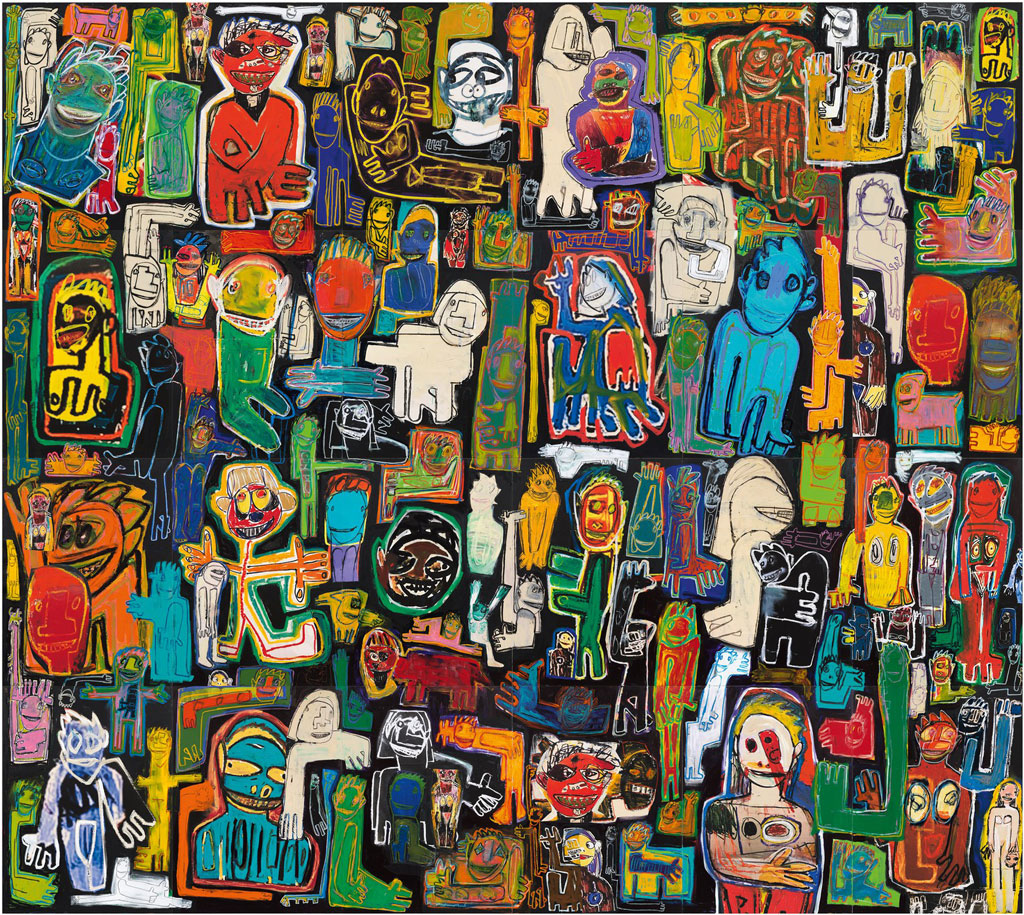ART-PRESENTATION: Richard Prince-High Times
 Before Prince ever became a leading figure of the Pictures Generation, he was a teen who enjoyed drawing and loved Jackson Pollock. Eventually he gave up those ideas for the heady conceptualism of the ‘70s New York art scene. However, as he became an art world darling, Prince grew up and isolated himself outside of the city. By the 2000s, he was a father watching his own children draw. He missed the pleasure of making and doing, so Prince began to make paintings that collaged together various materials, like charcoal, oil stick, inkjet prints, and acrylic paint. The results are certainly the most tactile and vibrant of the artist’s career, and recall not his own work of the 1980s, but the work of a style from the same era: the Neo-Expressionists.
Before Prince ever became a leading figure of the Pictures Generation, he was a teen who enjoyed drawing and loved Jackson Pollock. Eventually he gave up those ideas for the heady conceptualism of the ‘70s New York art scene. However, as he became an art world darling, Prince grew up and isolated himself outside of the city. By the 2000s, he was a father watching his own children draw. He missed the pleasure of making and doing, so Prince began to make paintings that collaged together various materials, like charcoal, oil stick, inkjet prints, and acrylic paint. The results are certainly the most tactile and vibrant of the artist’s career, and recall not his own work of the 1980s, but the work of a style from the same era: the Neo-Expressionists.
By Efi Michalarou
Photo: Gagosian Gallery Archive
Richard Prince in his solo exhibition “High Times” at Gagosian Gallery in San Francisco presents new mixed-media paintings alongside his “Hippie Drawings” series that were featured in the periodical for marijuana enthusiasts, High Times magazine’s, September 2016 issue. Richard Prince has redefined the concepts of authorship, ownership, and aura. Applying his understanding of the complex transactions of representation to the making of art, he evolved a unique signature filled with echoes of other signatures yet that is unquestionably his own. An avid collector and perceptive chronicler of American subcultures and vernaculars and their role in the construction of American identity, he has probed the depths of racism, sexism, and psychosis in mainstream humor; the mythical status of cowboys, bikers, customized cars, and celebrities; and most recently, the push–pull allure of pulp fiction and soft porn, producing such unlikely icons as the highly coveted “Nurse paintings”. Richard Prince after digging his kids’ drawings, he got to thinking of making drawings based on what he thought a hippie would draw. The “Hippie Drawings” that he started making in 1998 and continued to draw for the next couple of years were supposed to be shown in London in early 2000. But, for reasons he can’t explain, he canceled the show and instead just published the catalogue. “At least you had reproductions of the drawings. I was always thinking about the idea of ‘at least’ and ‘almost’ all the time.” High Times saw images of the work and asked Prince to create a cover for their publication. In a way, this all connects back to the earliest iterations of these works in the late 1990s. Called “Hippie Drawings”, Prince made drawings that he thought the hippies would create. Obviously, this connection between the American imagination and recreational drugs dovetails nicely with the branding of High Times. This collaboration also led to the creation of more work, and eventually, this very exhibition. “Super Group” started off simple. One day Richard Prince removed a 33 1/3 rpm record from its sleeve. He held the sleeve in his hand and stared at it. g. Without thinking Richard took a pencil and signed the sleeve: “To Richard Hell from another Richard Hell”, framed it, and hung it in his studio. It hung there for a year. After a year Richard Prince went through his record collection and found nine Sonic Youth albums. He removed all the records from their sleeves and gridded and pasted the sleeves with white acrylic paint onto a canvas. He called the painting “Nine Sonic Youths”. Richard Prince said he had only three Kinks records in his collection, so he had to go to a used record store to get some more. That changed things. What it changed is going to a used record store. One, he started going more. And two, he wasn’t buying records for the record but for the sleeve the record is in. Six months after discovering he could buy all kinds of record sleeves on the Internet, this made using sleeves as a background a lot easier than going to a used record store. He had started writing the names of bands directly onto the sleeves. Writing out the names of groups like Cream and Blind Faith, groups that he grew up with, reminded him of the term used to describe what these two groups were supposed to be:
Info: Gagosian Gallery, 657 Howard Street, San Francisco, Duration: 30/5-23/8/19, Days & Hours: Mon-Sat 10:00-18:00, https://gagosian.com




